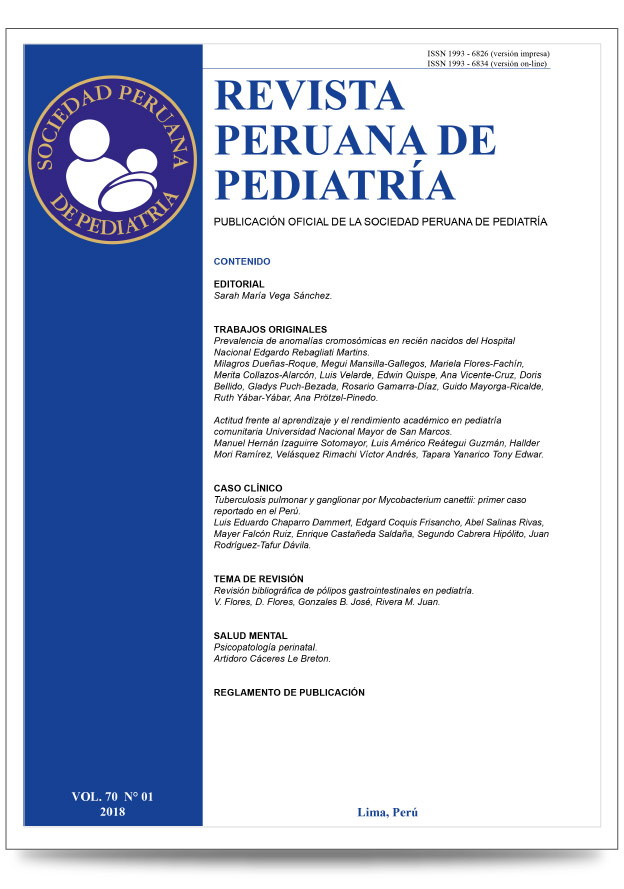Prevalence of chromosomal abnormalities in newborns of the Edgardo Rebagliati National Hospital
DOI:
https://doi.org/10.61651/rped.2018v70n1p10-18Keywords:
Chromosome Aberrations, Congenital Abnormalities, PrevalenciaAbstract
Objective: To determine the prevalence of chromosomal abnormalities and mortality in newborns of Edgardo Rebagliati Martins Hospital in the period January 2011 to December 2013.
Methods: Retrospective descriptive study. By reviewing medical records of newborns who had any abnormal chromosomes according logbook cytogenetics Laboratory. We analyzed, the prevalence, maternal age, number of pregnancy, gestational age, gender, birth weight, discharge status (alive or dead) and associated malformations.
Results: In the study period, there were 25,086 live births. Of these, 138 live newborns had a chromosomal aberration, with a prevalence of 0.6 %. There were 51 live newborns referred from other hospitals handling more complex so that, our sample consisted of 189 neonates of whom 51.9% were female. The most common chromosomal aberration was Down syndrome with 74.6% (n=141), followed by Edwards syndrome with 13.2 % (n=25) and Patau syndrome with 5.8 % (n=11), there was one case of Turner syndrome. The 5.28% had unbalanced structural abnormalities. Median survival was 17 days (95 % confidence interval [CI]: 12.6 to 21.3) for infants with trisomy 18 and 4 days (95 % [CI]: 2.5 to 5.4) for trisomy 13. Congenital heart disease was the most common associated malformation (67.2%).
Conclusions: The prevalence of chromosomal abnormalities found, emphasizes the need for karyotyping in malformed newborns in order to give proper advice to the family.
Downloads
Downloads
Published
How to Cite
License

This work is licensed under a Creative Commons Attribution 4.0 International License.
Authors will retain the copyright and grant the right to publish their work in the journal while allowing third parties to share it under the Creative Commons Attribution license.
Articles are published under a Creative Commons license that allows sharing and adaptation with appropriate credit. CC BY 4.0 license. Available in English at https://creativecommons.org/licenses/by/4.0/
Authors may use other information disclosure formats as long as the initial publication in the journal is cited. The dissemination of the work through the Internet is recommended to increase citations and promote academic exchanges.
The published content does not necessarily reflect the specific point of view of the journal, and the authors assume full responsibility for the content of their article.




